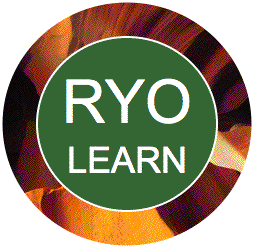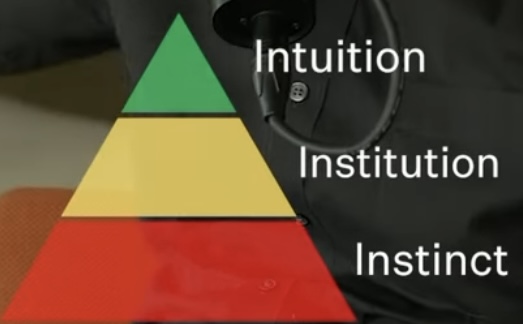
MASTERY
DECISION-MAKING
SELF-KNOWLEDGE
RESILIENCE
HUMILITY
INTELLECT
ADAPTABILITY
RESOLVE |
|
BUILD A DECISION-MAKING FRAMEWORK |
|
|
| ACTIVITY #1:
JOURNAL Your PRIMARY Responses
| |
We live in a complex world. In it we face ongoing challenges. At each step along, a variety of choices are presented.
How an individual handles these choices and challenges will either be confined or arrayed up to three decision making modes, viz.;
1. INSTINCTIVE
(governed by the reptillian brain, i.e. reactive)
2. INSTITUTIONAL
(guided by social and institutional pressures)
3. INTUITIVE
(influenced by mental, emotional and spiritual maturity)
An individual's customary pattern (1, 2 or 3) describes the outer limits of his/her capacity / attainable level of mental strength as well as his/her likely quality of life-outcomes.
WHICH (1, 2 or 3) DOMINATES YOUR DECISION MAKING?
A1: Journal how it guided your decison to enroll in this program. |
|
|
ACTIVITY #2:
JOURNAL Your PRIMARY Responses
| |
Consider the following thinking-styles (processes). Evaluate how each may be employed in order to improve your current strategy pursuing desires.
1. CRITICAL THINKING
- a disciplined checking of facts, assumptions, sources and biases in order to facilitate reasoned judgments based on evidence (ref SWOT analysis)
2. CREATIVE THINKING
- the use of imagination, experience and collaboration to connect learnings and ideas in novel and-or different ways in order to produce fresh, nuanced, innovative solutions (ref STORYBOARDING)
3. CONVERGENT THINKING
- connecting the dots: gathering facts and clues then sorting and aligning these, variably, in the search of the 'best' or 'right' solution (ref AFFINITY DIAGRAMS)
4. CONCRETE THINKING
- a focus on observable, measurable, experienced set of facts, which are then processed, as is guided by the conviction of what one asserts to be real (ref VISUAL THINKING)
WHICH MOST CLOSELY MATCH YOUR DEFAULT PROCESS?
A2a: USE that TO SOLVE 'PROBLEM 1' LISTED in 'TOPIC 2'
A2b: RESEARCH EACH OF THE referenced CONCEPTS |
|
|
ACTIVITY #3:
JOURNAL for on-going reference, review and discussions.
| |
Review your TOP 5 BELIEFS
Ascertain the positive and negative impacts your belief system has on your decision-making process. (Journal these.)
Beliefs and decision-making are inescapably enmeshed. On a scale of 1 (being bad) to 10 (being best), evaluate the success of the current alignment between your beliefs and your decision-making process.
A3a: What adjustment(s) should you make?
A3b: How will you make said adjustment(s)? |
|
|
ACTIVITY #4:
JOURNAL for on-going reference, review and discussions.
| |
Review your TOP 5 DESIRES
On a scale of 1 (being bad) to 10 (being best) evaluate the impact of your previously practiced decision-making process on achieving your top 5 desires.
What positive and negative impacts do you percieve your current (revised) decision-making process will have on achieving the stated desires?
A4: Highlight for ongoing reference. |
|
|
ACTIVITY #5:
Reframe your mindset to accomodate smart decision making
| |
"LIFE is a sequence of CHOICES. Every choice you make remakes you. (Trust your judgment. TAKE ACTION.)"
IMPORTANT: REVISE YOUR LISTED BELIEFS & DESIRES.
1. JOURNAL YOUR REVISED LIST OF TOP 5 BELIEFS
2. JOURNAL YOUR REVISED LIST OF TOP 5 DESIRES
(You will be refering to this revised version during upcoming modules.)
|
NOTE: "The quality of your life ultimately depends on the quality of your decisions." Ray Dalo
|
NOTE: "We are the creative force of our life, and through our own decisions rather than our conditions, if we carefully learn to do certain things, we can accomplish those results." Stephen Covey
|
Journal YOUR reflections.
A5: HIGHLIGHT YOUR REVISED LISTS. |
|
|
CONSIDER THE FOLLOWING DECISION-MAKING FRAMEWORK: |
|
|
ACTIVITY #6:
| |
1. REFLECT on one of your earliest childhood memories.
2. CONSIDER how it impacts your chances and choices.
3. READ the following sections of Riding Moby Dick:
a) Experience #2 - Grease Bag
b) Second Reflection - The Seeker & The Source
A6: Complete EXERCISES assigned in TOPIC 2
|
|
|
NOTE: Memory-makers are life's flashcards reminding us of lessons we were taught and what we need to know. Everything we need to know we learn along our journey. |
DESIGN your decision-making framework.
|
|
|
ACTIVITY #7:
'The Big Problem.'
| |
The world's top percentile of SUCCESSFUL INNOVATORS / CREATORS / CHANGE-MAKERS design and-or adopt EFFECTIVE SYSTEMS rather than just GOALS to produce outstanding achievements.
THE BIG DECISION! Name the obstacle / challenge you perceive can derail your success or curtail your progress.
Identify & Define.
A7a: Highlight
|
YOUR NEW DECISION-MAKING FRAMEWORK:
How does 'who you are' fit with your top desires?
How does your top desires fit in your world/environment?
How does your environment fit with who you are?
A7b: ANNOTATE for future reference
|
NEW HABIT 3: Mental Strength Sustainability (coordinate with coach)
Create an ESSENTIAL HABITS SECTION
A7c: List & Practice THESE NEW HABITS |
DAILY EXERCISE: Sharpen Your Critical Thinking Skills
|
|
|
|
About Us
|
Find Us
|
Personal Support Services
|
Community Connection
|
RyoSports - a PRG Sports Network member - Copyright 2014-25


